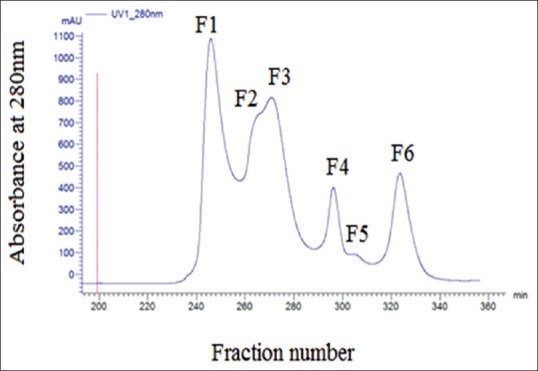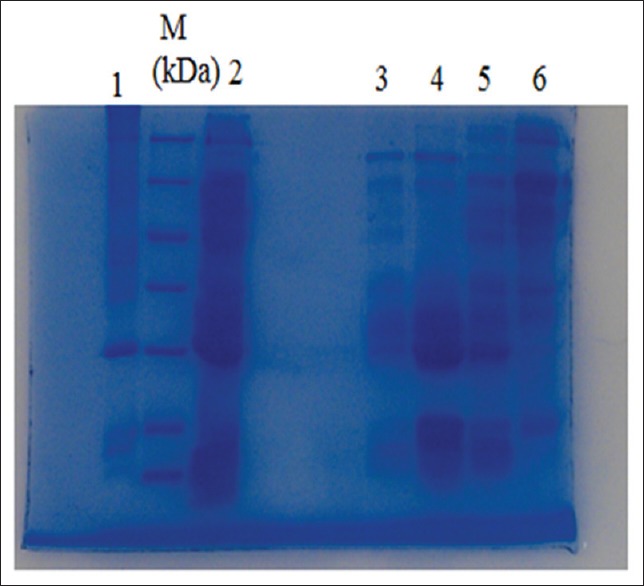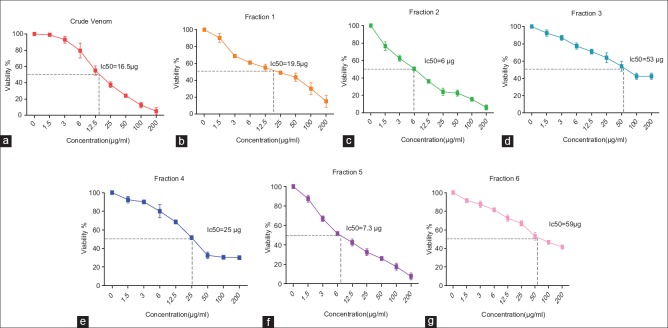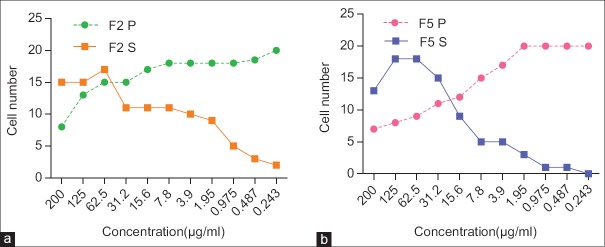Abstract
Background:
Cancer is one of the major health problems worldwide. Hence, finding potent therapeutics from natural sources seems necessary. Snake venom of Vipera lebetina contains potential component with anticancer activities such as antiproliferation, migration, invasion, adhesion, and angiogenesis effect. Evaluation of cytotoxic and antiadhesive effect of V. lebetina venom on lung epithelial cancer tumor cell (TC-1) was the main aim of this study.
Materials and Methods:
Here, we purified snake venom of V. lebetina by fast protein liquid chromatography (FPLC) using Sephacryl S-200 hr column. The fractions collected and evaluated by SDS-PAGE analysis. The cytotoxicity and antiadhesive effect of crude venom and fractions on TC-1 cells were demonstrated using 3-(4,5-dimethylthiazol-2-yl)-2,5-diphenyltetrazolium bromide and adhesion assay, respectively.
Results:
Our results showed six fractions in FPLC diagram. V. lebetina crude venom and fractions showed dose-dependent cytotoxic effect on TC-1 cells. Fractions 2 and 5 showed high cytotoxic effect with high IC50 value (IC50 = 6 μg/ml for fraction 2 and IC50 = 7.3 μg/ml for fraction 5). Fractions 2 and 5 selected for analysis antiadhesive effect on TC-1 cells. Furthermore, our results showed that both fractions 2 and 5 had antiadhesive effect on TC-1 cells.
Conclusion:
Because of potent cytotoxic and antiadhesive effect of V. lebetina fractions on lung epithelial cancer cell line, it could be promising tools for further analysis as anticancer therapeutic development.
Keywords: Antiadhesion, cancer, cytotoxicity, snake venom, Vipera lebetina
Introduction
Lung cancer referred as one of the major concerns in the worldwide. According to the increasing number of lung cancer, it seems necessary to find novel therapeutics from natural sources that can potently inhibit or kill cancer cells.[1] Snake venom contains various proteins and peptides with pharmacological and physiological properties.[2] Snake venom causes disruptions in breathing, weakness, drowsiness, cardiogenic shock, respiratory disorders, and ultimately death. Therapeutic drugs such as antihypertension, antistroke, and anticoagulant have been evaluated from snake venom.[3,4,5] Snake venom consists of proteins including disintegrins, metalloproteinases, phospholipases, serine proteases, and C-type lectins.[6] The C-type proteins in snake venom have a binding region for calcium and sugar. However, in snake venom, there is also C-type lectins such as proteins named snaclecs which do not have binding region for calcium and sugar.[7] Snaclecs are heterodimers with 25 kDa consisting of αβ units covalently linked together with disulphide bond.[8] They act as potent inhibitors of αvβ3 and α5β1 integrins, tumor invasion, adhesion, migration, proliferation, and angiogenesis.[9] They also known as antiplatelet proteins and resulted in blockade of Von Willebrand factor.[10] The inhibitory effect of snaclecs on adhesion of different cancer cell lines has been evaluated.[7,9] Application of snake venom has been evaluated in ancient medicine for increasing life span.[1] Thus, snake venom was used in homeopathic medicine. Snake venom of Vipera lebetina turanica showed chemotherapeutic potency through induction of apoptosis in prostate cancer,[5] neuroblastoma cells,[11] and colon cancer cells.[12] In this study, for the first time, we evaluated cytotoxic and antiadhesive effects of Iranian V. lebetina turanica crude venom and fractions on lung epithelial tumor cells (TC-1).
Materials and Methods
V. lebetina snake venom was collected in Serpentarium of Pasteur Institute of Iran, Tehran, Iran. TC-1 lung epithelial tumor cell line (ATCC: CRL-2785) was purchased from Iranian National Cell Bank. TC-1 cell was cultured in RPMI 1640 medium (Sigma, USA) supplemented by 10% inactivated fetal bovine serum (FBS) (Gibco, USA), penicillin 100U/ml, and streptomycin 100 μg/ml (Gibco, USA) and incubated at 37°C in humidified atmosphere containing 5% CO2.
Vipera lebetina snake venom fractionating
About 50 mg of lyophilized venom of V. lebetina was dissolved in 500 μl of 20 mM ammonium acetate, pH 6.8 and loaded on Sephacryl S-200 hr column (GE Healthcare, Biosciences). The column was equilibrated with 20 mM ammonium acetate, pH 6.8. The elution of fractions was performed using flow rate of 1 ml/min. All the fractions were pooled separately and lyophilized. The protein concentration was determined by the BCA protein assay kit according to the manufacturer's instruction (Pierce Rochford, USA). All eluted fractions evaluated using SDS-PAGE 15% under reducing condition.
Cytotoxicity assay
Cytotoxicity effect of V. lebetina on TC-1 cells was evaluated using 3-(4, 5-dimethylthiazol-2-yl)-2,5-diphenyltetrazolium bromide (MTT) assay. About 1.5 × 105 cells seeded in 96-well plate containing 200 μl RPMI 1640, penicillin 100U/ml, streptomycin 100 μg/ml, and FBS 10% and incubated at 37°C and 5% CO2 for 24 h. Then, cells were treated with various concentrations of V. lebetina crude venom and fractions (0–200 μg/ml). After 24-h incubation at same culture condition, 20 μl of MTT solution (5 mg/ml of PBS) (Sigma) added to each well, and plate incubated in dark at 37°C. After 4-h incubation, 100 μl DMSO (dimethyl sulfoxide) (Sinaclon, Bioscience) added to the wells, and absorbance was measured at 570 nm using spectrophotometer (Epoch, Bio Tek, USA).
Adhesion assay
About 2 × 104 TC-1 cells with RPMI 1640 medium supplemented by 10% FBS were cultured in 96-well plate with or without different concentration of fractions 2 and 5 (0–200 μg/ml), and plate incubated for 1 h at 37°C and 5% CO2. Then, the cells in supernatant of wells collected, centrifuged at 900 g for 1 min, counted and defined as nonadhesive cells. The adhesive cells also trypsinized, counted and defined as adhesive cells. The assay was performed triplicate.
Results
Purification results
Snake venom of V. lebetina was fractionated by fast protein liquid chromatography (FPLC). The fractions chromatogram is shown in Figure 1. As it can be seen, six fractions isolated using S-200 column. The purity and component of pooled fractions were evaluated by SDS-PAGE under reducing condition [Figure 2].
Figure 1.

Fast protein liquid chromatography. Crude venom of Macrovipera lebetina fractionated using fast protein liquid chromatography on Sephacryl S-200 hr column. Six individual fractions detected. Fractions 2 and 5 selected for further analysis
Figure 2.

Reducing 15% SDS-PAGE M; Protein marker (the MW of marker lanes from bottom to top was 10, 15, 25, 35, 40, and 55 kDa), lane 1; fraction 1, lane 2; fraction 2, lane 3; fraction 3, lane 4; fraction 4, lane 5; fraction 5, lane 6; and fraction 6
Cytotoxicity results
Cytotoxicity effect of V. lebetina venom was evaluated by MTT assay. Our results demonstrated inhibitory and cytotoxic effect of V. lebetina venom on TC-1 cells in dose-dependent manner [Figure 3]. The achieved IC50s were 16.5, 19.5, 6, 53, 25, 7.3, and 59 μg/ml for V. lebetina crude venom, fraction 1, fraction 2, fraction 3, fraction 4, fraction 5, and fraction 6, respectively. According to the results, fractions 2 and 5 showed high cytotoxic effect on proliferation of TC-1 cells. Therefore, fractions 2 and 5 selected for further analysis using antiadhesion assay.
Figure 3.
MTT assay results. antiproliferative and cytotoxic effect of V. lebetina venom were evaluated by MTT assay. IC50s calculated for each fraction and also crude venom. The assay was performed in triplicate, a) Crud venom, b) F1, c) F2, d) F3, e) F4, f) F5 and g) F6
Adhesion assay results
It has been demonstrated that in snake venom, there are potential anticancer agents with antiadhesion effect.[1] With that aim, we used fractions 2 and 5 (according to their high cytotoxicity effect) to evaluate their effect on adhesion of TC-1 cells to culture flask. Our results revealed that both fractions 2 and 5 had dose-dependent effect on TC-1 adhesion. However, this effect was different among fractions 2 and 5 [Figure 4]. In lower concentration of fractions 2 and 5, most of cells were adherent and low number of cells detected in supernatant (nonadhesive cells).
Figure 4.
Adhesion assay analysis of F2 (a) and F5 (b). As can be seen, anti-adhesive effect of F2 an F5 were higher in high fraction concentration.
Discussion
Here, we evaluated the cytotoxic effect of V. lebetina venom on TC-1 cells. Our results showed that V. lebetina crude venom had cytotoxic effect on TC-1 cells in dose-dependent manner and with increasing the venom concentration almost all cells died. Indeed, we showed fractions 2 and 5 of V. lebetina inhibited adhesion of TC-1 lung cancer cells in vitro. We also showed that this effect was dose dependent, and in higher concentration of venom fractions, more cells detected as nonadhesive. Our results are consistent with study of Jebali et al.[13] that showed snake venom could inhibit MDA-MB-231 cells proliferation and adhesion. In other study, Sarray et al. showed that snake venom could inhibit adhesion of human TC-1,[7] and our achieved results were consistent with their achievement. It has been believed that such effect is related to C-type lectin proteins.[7,9] Indeed, C-type lectin proteins have shown many antitumor effects,[14] with in vivo and in vitro antiangiogenesis activity.[15] C-type lectin proteins inhibit collagen receptor α2β1 and thereby, interfere with integrin activity.[9] Integrins are responsible for development of diseases such as cancer. Therefore, inhibiting integrin activity could be as possible therapies.[9]
Current studies in our laboratory focused on finding and development of potential molecules with therapeutic activity from snack or scorpion or other animal venoms and toxins. For this aim, we prepared snake venom toxin of V. lebetina and fractionated using Sephacryl S-200 hr column.[13] To the best of our knowledge, this is the first report describing cytotoxic and antiadhesive effect of Iranian V. lebetina venom on lung epithelial cancer cell line (TC-1). The cytotoxic effect of V. lebetina venom on human umbilical vein endothelial cells (HUVECs) cells evaluated by Kakanj et al.[16] Kakaj et al. in their study showed that V. lebetina crude venom had cytotoxic effect on HUVECs and inhibited HUVECs proliferation in dose-dependent manner.[16] Our study is consistent with Kakanj et al. study. However, we analyzed antiadhesive effect of V. lebetina venom on TC-1 cells. However, further analysis is going to evaluate V. lebetina effect on other cell lines.
Conclusion
We described the purification of snake venom of V. lebetina by FPLC and demonstrated the antiadhesive activity of snake venom toxin of V. lebetina on lung epithelial cancer cell line (TC-1). The results promise as novel therapeutics development from V. lebetina venom.
Financial support and sponsorship
Nil.
Conflicts of interest
There are no conflicts of interest.
References
- 1.Gomes A, Bhattacharjee P, Mishra R, Biswas AK, Dasgupta SC, Giri B, et al. Anticancer potential of animal venoms and toxins. Indian J Exp Biol. 2010;48:93–103. [PubMed] [Google Scholar]
- 2.Pal SK, Gomes A, Dasgupta SC, Gomes A. Snake venom as therapeutic agents: From toxin to drug development. Indian J Exp Biol. 2002;40:1353–8. [PubMed] [Google Scholar]
- 3.Birrell GW, Earl ST, Wallis TP, Masci PP, de Jersey J, Gorman JJ, et al. The diversity of bioactive proteins in Australian Snake Venoms. Mol Cell Proteomics. 2007;6:973–86. doi: 10.1074/mcp.M600419-MCP200. [DOI] [PubMed] [Google Scholar]
- 4.Markland FS. Snake venoms and the hemostatic system. Toxicon. 1998;36:1749–800. doi: 10.1016/s0041-0101(98)00126-3. [DOI] [PubMed] [Google Scholar]
- 5.Son DJ, Park MH, Chae SJ, Moon SO, Lee JW, Song HS, et al. Inhibitory effect of snake venom toxin from Vipera lebetina turanica on hormone-refractory human prostate cancer cell growth: Induction of apoptosis through inactivation of nuclear factor kappaB. Mol Cancer Ther. 2007;6:675–83. doi: 10.1158/1535-7163.MCT-06-0328. [DOI] [PubMed] [Google Scholar]
- 6.Ogawa T, Chijiwa T, Oda-Ueda N, Ohno M. Molecular diversity and accelerated evolution of C-type lectin-like proteins from snake venom. Toxicon. 2005;45:1–4. doi: 10.1016/j.toxicon.2004.07.028. [DOI] [PubMed] [Google Scholar]
- 7.Sarray S, Berthet V, Calvete JJ, Secchi J, Marvaldi J, El-Ayeb M, et al. Lebectin, a novel C-type lectin from Macrovipera lebetina venom, inhibits integrin-mediated adhesion, migration and invasion of human tumour cells. Lab Invest. 2004;84:573–81. doi: 10.1038/labinvest.3700088. [DOI] [PubMed] [Google Scholar]
- 8.Marcinkiewicz C. Applications of snake venom components to modulate integrin activities in cell-matrix interactions. Int J Biochem Cell Biol. 2013;45:1974–86. doi: 10.1016/j.biocel.2013.06.009. [DOI] [PMC free article] [PubMed] [Google Scholar]
- 9.Sarray S, Delamarre E, Marvaldi J, El Ayeb M, Marrakchi N, Luis J, et al. Lebectin and lebecetin, two C-type lectins from snake venom, inhibit alpha5beta1 and alphaV-containing integrins. Matrix Biol. 2007;26:306–13. doi: 10.1016/j.matbio.2007.01.001. [DOI] [PubMed] [Google Scholar]
- 10.Clemetson KJ, Lu Q, Clemetson JM. Snake C-type lectin-like proteins and platelet receptors. Pathophysiol Haemost Thromb. 2005;34:150–5. doi: 10.1159/000092414. [DOI] [PubMed] [Google Scholar]
- 11.Park MH, Son DJ, Kwak DH, Song HS, Oh KW, Yoo HS, et al. Snake venom toxin inhibits cell growth through induction of apoptosis in neuroblastoma cells. Arch Pharm Res. 2009;32:1545–54. doi: 10.1007/s12272-009-2106-0. [DOI] [PubMed] [Google Scholar]
- 12.Park MH, Jo M, Won D, Song HS, Han SB, Song MJ, et al. Snake venom toxin from vipera lebetina turanica induces apoptosis of colon cancer cells via upregulation of ROS- and JNK-mediated death receptor expression. BMC Cancer. 2012;12:228. doi: 10.1186/1471-2407-12-228. [DOI] [PMC free article] [PubMed] [Google Scholar]
- 13.Jebali J, Fakhfekh E, Morgen M, Srairi-Abid N, Majdoub H, Gargouri A, et al. Lebecin, a new C-type lectin like protein from Macrovipera lebetina venom with anti-tumor activity against the breast cancer cell line MDA-MB231. Toxicon. 2014;86:16–27. doi: 10.1016/j.toxicon.2014.04.010. [DOI] [PubMed] [Google Scholar]
- 14.Jakubowski P, Calvete JJ, Eble JA, Lazarovici P, Marcinkiewicz C. Identification of inhibitors of α2β1 integrin, members of C-lectin type proteins, in Echis sochureki venom. Toxicol Appl Pharmacol. 2013;269:34–42. doi: 10.1016/j.taap.2013.03.002. [DOI] [PMC free article] [PubMed] [Google Scholar]
- 15.Momic T, Arlinghaus FT, Arien-Zakay H, Katzhendler J, Eble JA, Marcinkiewicz C, et al. Pharmacological aspects of vipera xantina palestinae venom. Toxins (Basel) 2011;3:1420–32. doi: 10.3390/toxins3111420. [DOI] [PMC free article] [PubMed] [Google Scholar]
- 16.Kakanj M, Ghazi-Khansari M, Zare Mirakabadi A, Daraei B, Vatanpour H. Cytotoxic effect of Iranian vipera lebetina snake venom on HUVEC cells. Iran J Pharm Res. 2015;14:109–14. [PMC free article] [PubMed] [Google Scholar]




